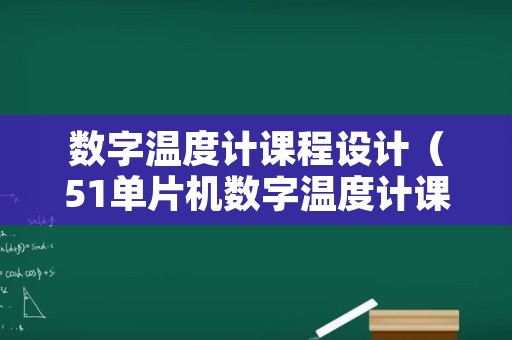数字温度计课程设计(51单片机数字温度计课程设计)
- 天气预报
- 2023-05-01
- 44
单片机课程设计,数字温度计。1.实验任务用可调电阻调节电压值作为模拟温度的输入量,当温度低于30℃时,发出长嘀报警声和光报警,当温度高于60℃时,发出短嘀报警声和光报警。测量的温度范围在0-99℃。b)把“单片机系统”区域中的P2.0-P2.7与“动态数码显示”区域中的S1S2S3S4S5S6S7S8端口用8芯排线连接。d)把“单片机系统”区域中的P3.1与“模数转换模块”区域中的OE端子用导线相连接。j)把“单片机系统”区域中的P3.6、P3.7用导线分别连接到“八路发光二极管指示模块”区域中的L1、L2上。在proteus中用74hc573,做数码管显示的仿真。
单片机课程设计,数字温度计。

1. 实验任务
用可调电阻调节电压值作为模拟温度的输入量,当温度低于30℃时,发出长嘀报警声和光报警,当温度高于60℃时,发出短嘀报警声和光报警。测量的温度范围在0-99℃。
2. 电路原理图
(图)见插图
3. 系统板上硬件连线
a) 把“单片机系统”区域中的P1.0-P1.7与“动态数码显示”区域中的ABCDEFGH端口用8芯排线连接。
b) 把“单片机系统”区域中的P2.0-P2.7与“动态数码显示”区域中的S1S2S3S4S5S6S7S8端口用8芯排线连接。
c) 把“单片机系统”区域中的P3.0与“模数转换模块”区域中的ST端子用导线相连接。
d) 把“单片机系统”区域中的P3.1与“模数转换模块”区域中的OE端子用导线相连接。
e) 把“单片机系统”区域中的P3.2与“模数转换模块”区域中的EOC端子用导线相连接。
f) 把“单片机系统”区域中的P3.3与“模数转换模块”区域中的CLK端子用导线相连接。
g) 把“模数转换模块”区域中的A2A1A0端子用导线连接到“电源模块”区域中的GND端子上。
h) 把“模数转换模块”区域中的IN0端子用导线连接到“三路可调电压模块”区域中的VR1端子上。
i) 把“单片机系统”区域中的P0.0-P0.7用8芯排线连接到“模数转换模块”区域中的D0D1D2D3D4D5D6D7端子上。
j) 把“单片机系统”区域中的P3.6、P3.7用导线分别连接到“八路发光二极管指示模块”区域中的L1、L2上。
k) 把“单片机系统”区域中的P3.5用导线连接到“音频放大模块”区域中的SPK IN端口上。
l) 把“音频放大模块“区域中的SPK OUT插入音频喇叭。
四.C语言源程序
#include AT89X52.H
unsigned char code dispbitcode[]={0xfe,0xfd,0xfb,0xf7,
0xef,0xdf,0xbf,0x7f};
unsigned char code dispcode[]={0x3f,0x06,0x5b,0x4f,0x66,
0x6d,0x7d,0x07,0x7f,0x6f,0x00};
unsigned char dispbuf[8]={10,10,10,10,10,10,0,0};
unsigned char dispcount;
unsigned char getdata;
unsigned int temp;
unsigned char i;
sbit ST=P3^0;
sbit OE=P3^1;
sbit EOC=P3^2;
sbit CLK=P3^3;
sbit LED1=P3^6;
sbit LED2=P3^7;
sbit SPK=P3^5;
bit lowflag;
bit highflag;
unsigned int cnta;
unsigned int cntb;
bit alarmflag;
void main(void)
{
ST=0;
OE=0;
TMOD=0x12;
TH0=0x216;
TL0=0x216;
TH1=(65536-500)/256;
TL1=(65536-500)%256;
TR1=1;
TR0=1;
ET0=1;
ET1=1;
EA=1;
ST=1;
ST=0;
while(1)
{
if((lowflag==1) (highflag==0))
{
LED1=0;
LED2=1;
}
else if((highflag==1) (lowflag==0))
{
LED1=1;
LED2=0;
}
else
{
LED1=1;
LED2=1;
}
}
}
void t0(void) interrupt 1 using 0
{
CLK=~CLK;
}
void t1(void) interrupt 3 using 0
{
TH1=(65536-500)/256;
TL1=(65536-500)%256;
if(EOC==1)
{
OE=1;
getdata=P0;
OE=0;
temp=getdata*25;
temp=temp/64;
i=6;
dispbuf[0]=10;
dispbuf[1]=10;
dispbuf[2]=10;
dispbuf[3]=10;
dispbuf[4]=10;
dispbuf[5]=10;
dispbuf[6]=0;
dispbuf[7]=0;
while(temp/10)
{
dispbuf[i]=temp%10;
temp=temp/10;
i++;
}
dispbuf[i]=temp;
if(getdata77)
{
lowflag=1;
highflag=0;
}
else if(getdata153)
{
lowflag=0;
highflag=1;
}
else
{
lowflag=0;
highflag=0;
}
ST=1;
ST=0;
}
P1=dispcode[dispbuf[dispcount]];
P2=dispbitcode[dispcount];
dispcount++;
if(dispcount==8)
{
dispcount=0;
}
if((lowflag==1) (highflag==0))
{
cnta++;
if(cnta==800)
{
cnta=0;
alarmflag=~alarmflag;
}
if(alarmflag==1)
{
SPK=~SPK;
}
}
else if((lowflag==0) (highflag==1))
{
cntb++;
if(cntb==400)
{
cntb=0;
alarmflag=~alarmflag;
}
if(alarmflag==1)
{
SPK=~SPK;
}
}
else
{
alarmflag=0;
cnta=0;
cntb=0;
}
}
数字温度计单片机课程设计用74LS573驱动4位数码管
在proteus中用74hc573,做数码管显示的仿真。
#includereg52.h
#includeintrins.h
#define uint unsigned int
#define uchar unsigned char
void delay(uint z);
uchar temp,aa,numdu,numwe,bai,shi,ge;
uint shu;
void init();
sbit dula=P2^6;
sbit wela=P2^7;
uchar code table[]={
0x3f , 0x06 , 0x5b , 0x4f ,
0x66 , 0x6d , 0x7d ,
0x07, 0x7f , 0x6f ,
0x77, 0x7c , 0x39 ,0x5e ,0x79 ,
0x71 ,0x00
};
void display(uchar bai,uchar shi,uchar ge);
void main()
{
shu=219;
init();
while(1)
{
display(bai,shi,ge);
}
}
void delay(uint z)
{
uint x,y;
for(x=z;x0;x--)
for(y=110;y0;y--);
}
void display(uchar bai,uchar shi,uchar ge)
{
wela=1;
P0=0xfe;
wela=0;
dula=1;
P0=table[bai];
dula=0;
delay(1);
wela=1;
P0=0xfd;
wela=0;
dula=1;
P0=table[shi];
dula=0;
delay(1);
wela=1;
P0=0xfb;
wela=0;
dula=1;
P0=table[ge];
dula=0;
delay(1);
}
void init()
{
TMOD=0x01;
TH0=(65536-50000)/256;
TL0=(65536-50000)%256;
EA=1;
ET0=1;
TR0=1;
}
void timer0() interrupt 1
{
TH0=(65536-50000)/256;
TL0=(65536-50000)%256;
aa++;
if(aa==2)
{
aa=0;
shu--;
if(shu==10)
{
TR0=0;
ET0=0;
}
bai=shu/100;
shi=shu%100/10;
ge=shu%10;
}
}
关于制作简易数字温度计
单片机89C51,ADC0832,铂电阻测温PT1000,外接的稳压电源TL431,一些外围的器件电阻电容晶振,LED显示的话需要LED驱动IC,或者用IO口控制三极管来驱动LED,温度上限下限设定在程序中,到了限制就用IO口点亮发光二极管或者驱动小蜂鸣器,这些都是典型的,网上有不少例程
数字温度计单片机课程设计
用DS18B20来做就简单了,DS18B20是数字器件,测温范围:-55℃到+125℃,精度误差小于0.5℃,MCS51单片机可直接读出温度值,中途的信号放大、A/D转换都不需要。程序网上海了。
关于LCD数字显示温度计的课程设计,急,重赏
/*电子时钟源代码*/
#includegraphics.h
#includestdio.h
#includemath.h
#includedos.h
#define PI 3.1415926 /*定义常量*/
#define UP 0x4800 /*上移↑键:修改时间*/
#define DOWN 0x5000 /*下移↓键:修改时间*/
#define ESC 0x11b /*ESC键 : 退出系统*/
#define TAB 0xf09 /*TAB键 : 移动光标*/
/*函数声明*/
int keyhandle(int,int); /*键盘按键判断,并调用相关函数处理*/
int timeupchange(int); /*处理上移按键*/
int timedownchange(int); /*处理下移按键*/
int digithour(double); /*将double型的小时数转换成int型*/
int digitmin(double); /*将double型的分钟数转换成int型*/
int digitsec(double); /*将double型的秒钟数转换成int型*/
void digitclock(int,int,int ); /*在指定位置显示时钟或分钟或秒钟数*/
void drawcursor(int); /*绘制一个光标*/
void clearcursor(int);/*消除前一个光标*/
void clockhandle(); /*时钟处理*/
double h,m,s; /*全局变量:小时,分,秒*/
double x,x1,x2,y,y1,y2; /*全局变量:坐标值*/
struct time t[1];/*定义一个time结构类型的数组*/
main()
{
int driver, mode=0,i,j;
driver=DETECT; /*自动检测显示设备*/
initgraph(driver, mode, "");/*初始化图形系统*/
setlinestyle(0,0,3); /*设置当前画线宽度和类型:设置三点宽实线*/
setbkcolor(0);/*用调色板设置当前背景颜色*/
setcolor(9); /*设置当前画线颜色*/
line(82,430,558,430);
line(70,62,70,418);
line(82,50,558,50);
line(570,62,570,418);
line(70,62,570,62);
line(76,56,297,56);
line(340,56,564,56); /*画主体框架的边直线*/
/*arc(int x, int y, int stangle, int endangle, int radius)*/
arc(82,62,90,180,12);
arc(558,62,0,90,12);
setlinestyle(0,0,3);
arc(82,418,180,279,12);
setlinestyle(0,0,3);
arc(558,418,270,360,12); /*画主体框架的边角弧线*/
setcolor(15);
outtextxy(300,53,"CLOCK"); /*显示标题*/
setcolor(7);
rectangle(342,72,560,360); /*画一个矩形,作为时钟的框架*/
setwritemode(0); /*规定画线的方式。mode=0, 则表示画线时将所画位置的原来信息覆盖*/
setcolor(15);
outtextxy(433,75,"CLOCK");/*时钟的标题*/
setcolor(7);
line(392,310,510,310);
line(392,330,510,330);
arc(392,320,90,270,10);
arc(510,320,270,90,10); /*绘制电子动画时钟下的数字时钟的边框架*/
/*绘制数字时钟的时分秒的分隔符*/
setcolor(5);
for(i=431;i=470;i+=39)
for(j=317;j=324;j+=7){
setlinestyle(0,0,3);
circle(i,j,1); /*以(i, y)为圆心,1为半径画圆*/
}
setcolor(15);
line(424,315,424,325); /*在运行电子时钟前先画一个光标*/
/*绘制表示小时的圆点*/
for(i=0,m=0,h=0;i=11;i++,h++){
x=100*sin((h*60+m)/360*PI)+451;
y=200-100*cos((h*60+m)/360*PI);
setlinestyle(0,0,3);
circle(x,y,1);
}
/*绘制表示分钟或秒钟的圆点*/
for(i=0,m=0;i=59;m++,i++){
x=100*sin(m/30*PI)+451;
y=200-100*cos(m/30*PI);
setlinestyle(0,0,1);
circle(x,y,1);
}
/*在电子表的左边打印帮助提示信息*/
setcolor(4);
outtextxy(184,125,"HELP");
setcolor(15);
outtextxy(182,125,"HELP");
setcolor(5);
outtextxy(140,185,"TAB : Cursor move");
outtextxy(140,225,"UP : Time ++");
outtextxy(140,265,"DOWN: Time --");
outtextxy(140,305,"ESC : Quit system!");
outtextxy(140,345,"Version : 2.0");
setcolor(12);
outtextxy(150,400,"Nothing is more important than time!");
clockhandle();/*开始调用时钟处理程序*/
closegraph(); /*关闭图形系统*/
return 0; /*表示程序正常结束,向操作系统返回一个0值*/
}
void clockhandle()
{
int k=0,count;
setcolor(15);
gettime(t);/*取得系统时间,保存在time结构类型的数组变量中*/
h=t[0].ti_hour;
m=t[0].ti_min;
x=50*sin((h*60+m)/360*PI)+451; /*时针的x坐标值*/
y=200-50*cos((h*60+m)/360*PI); /*时针的y坐标值*/
line(451,200,x,y);/*在电子表中绘制时针*/
x1=80*sin(m/30*PI)+451; /*分针的x坐标值*/
y1=200-80*cos(m/30*PI); /*分针的y坐标值*/
line(451,200,x1,y1); /*在电子表中绘制分针*/
digitclock(408,318,digithour(h)); /*在数字时钟中,显示当前的小时值*/
digitclock(446,318,digitmin(m)); /*在数字时钟中,显示当前的分钟值*/
setwritemode(1);
/*规定画线的方式,如果mode=1,则表示画线时用现在特性的线
与所画之处原有的线进行异或(XOR)操作,实际上画出的线是原有线与现在规定
的线进行异或后的结果。因此, 当线的特性不变, 进行两次画线操作相当于没有
画线,即在当前位置处清除了原来的画线*/
for(count=2;k!=ESC;){ /*开始循环,直至用户按下ESC键结束循环*/
setcolor(12);/*淡红色*/
sound(500);/*以指定频率打开PC扬声器,这里频率为500Hz*/
delay(700);/*发一个频率为500Hz的音调,维持700毫秒*/
sound(200);/*以指定频率打开PC扬声器,这里频率为200Hz*/
delay(300);
/*以上两种不同频率的音调,可仿真钟表转动时的嘀哒声*/
nosound(); /*关闭PC扬声器*/
s=t[0].ti_sec;
m=t[0].ti_min;
h=t[0].ti_hour;
x2=98*sin(s/30*PI)+451; /*秒针的x坐标值*/
y2=200-98*cos(s/30*PI); /*秒针的y坐标值*/
line(451,200,x2,y2);
/*绘制秒针*/
/*利用此循环,延时一秒*/
while(t[0].ti_sec==st[0].ti_min==mt[0].ti_hour==h)
{ gettime(t);/*取得系统时间*/
if(bioskey(1)!=0){
k=bioskey(0);
count=keyhandle(k,count);
if(count==5) count=1;
}
}
setcolor(15);
digitclock(485,318,digitsec(s)+1);/*数字时钟增加1秒*/
setcolor(12); /*淡红色*/
x2=98*sin(s/30*PI)+451;
y2=200-98*cos(s/30*PI);
line(451,200,x2,y2);
/*用原来的颜色在原来位置处再绘制秒针,以达到清除当前秒针的目的*/
/*分钟处理*/
if(t[0].ti_min!=m){ /*若分钟有变化*/
/*消除当前分针*/
setcolor(15); /*白色*/
x1=80*sin(m/30*PI)+451;
y1=200-80*cos(m/30*PI);
line(451,200,x1,y1);
/*绘制新的分针*/
m=t[0].ti_min;
digitclock(446,318,digitmin(m)); /*在数字时钟中显示新的分钟值*/
x1=80*sin(m/30*PI)+451;
y1=200-80*cos(m/30*PI);
line(451,200,x1,y1);
}
/*小时处理*/
if((t[0].ti_hour*60+t[0].ti_min)!=(h*60+m)){ /*若小时数有变化*/
/*消除当前时针*/
setcolor(15); /*白色*/
x=50*sin((h*60+m)/360*PI)+451;/*50:时钟的长度(单位:像素),451:圆心的x坐标值*/
y=200-50*cos((h*60+m)/360*PI);
line(451,200,x,y);
/*绘制新的时针*/
h=t[0].ti_hour;
digitclock(408,318,digithour(h));
x=50*sin((h*60+m)/360*PI)+451;
y=200-50*cos((h*60+m)/360*PI);
line(451,200,x,y);
}
}
}
int keyhandle(int key,int count) /*键盘控制 */
{ switch(key)
{case UP: timeupchange(count-1); /*因为count的初始值为2,所以此处减1*/br break;br case DOWN:timedownchange(count-1); /*因为count的初始值为2,所以此处减1*/br break;br case TAB:setcolor(15);br clearcursor(count); /*清除原来的光标*/br drawcursor(count); /*显示一个新的光标*/br count++;br break;br }
return count;
}
int timeupchange(int count) /*处理光标上移的按键*/
{
if(count==1){
t[0].ti_hour++;
if(t[0].ti_hour==24) t[0].ti_hour=0;
settime(t); /*设置新的系统时间*/
}
if(count==2){
t[0].ti_min++;
if(t[0].ti_min==60) t[0].ti_min=0;
settime(t); /*设置新的系统时间*/
}
if(count==3){
t[0].ti_sec++;
if(t[0].ti_sec==60) t[0].ti_sec=0;
settime(t); /*设置新的系统时间*/
}
}
int timedownchange(int count) /*处理光标下移的按键*/
{
if(count==1) {
t[0].ti_hour--;
if(t[0].ti_hour==0) t[0].ti_hour=23;
settime(t);/*设置新的系统时间*/
}
if(count==2) {
t[0].ti_min--;
if(t[0].ti_min==0) t[0].ti_min=59;
settime(t);/*设置新的系统时间*/
}
if(count==3) {
t[0].ti_sec--;
if(t[0].ti_sec==0) t[0].ti_sec=59;
settime(t);/*设置新的系统时间*/
}
}
int digithour(double h)/*将double型的小时数转换成int型*/
{int i;brfor(i=0;i=23;i++)br {if(h==i) return i;}
}
int digitmin(double m)/*将double型的分钟数转换成int型*/
{int i;brfor(i=0;i=59;i++)br {if(m==i) return i;}
}
int digitsec(double s) /*将double型的秒钟数转换成int型*/
{int i;brfor(i=0;i=59;i++)br {if(s==i) return i;}
}
void digitclock(int x,int y,int clock)/*在指定位置显示数字时钟:时\分\秒*/
{char buffer1[10];brsetfillstyle(0,2);brbar(x,y,x+15,328);brif(clock==60) clock=0;brsprintf(buffer1,"%d",clock);brouttextxy(x,y,buffer1);br}
void drawcursor(int count) /*根据count的值,画一个光标*/
{switch(count)br{br case 1:line(424,315,424,325);break;br case 2:line(465,315,465,325);break;br case 3:line(505,315,505,325);break;br }
}
void clearcursor(int count) /*根据count的值,清除前一个光标*/
{switch(count)br{br case 2:line(424,315,424,325);break;br case 3:line(465,315,465,325);break;br case 1:line(505,315,505,325);break;br }
}
声明:本网页内容旨在传播知识,若有侵权等问题请及时与本网联系,我们将在第一时间删除处理。
E-mail:langhai8@163.com
本文链接:https://www.wumai.net/tianqi/20221226053007.html